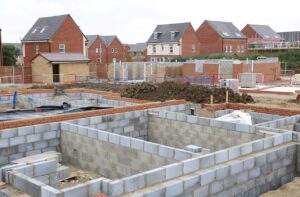Accelerating climate action through sustainable development within the built environment

Written by Ramsey Assal, CEO and Founder of property network, The Landsite
Ahead of Built Environment Day and COP26 is it time for the construction industry to embrace sustainable development to accelerate climate action?
COP26 shines the spotlight of attention across the globe on climate change and its impact. As the world becomes more environmentally aware, the movement towards sustainable practises is a requirement faced by all industries. However, in the development of both commercial and residential buildings, this is a complex challenge that needs to be considered from the earliest stages of planning to avoid significant adverse environmental impact.
A report by The Institute of Government and Public Policy (IGPP), found that the UK construction industry accounts for 45% of total carbon emissions – 27% of which from domestic buildings and 18% from non-domestic. With this, CO2 emissions from this sector will need to drop by at least 50% by 2030 to reach the Government net zero targets, which has led to the UK Government to stipulate a legally binding target of reducing emissions by 78% by 2035 in an effort to ensure targets are reached.
From this, it is clear that new building projects need to be designed to meet energy performance requirements and built using sustainable materials and methods. But even more importantly, 80% of the buildings that will be used in 2050 are already built, making decarbonising these buildings a priority. This means there is a need to modernise the nation’s existing built environment to operate sustainably to reach net zero targets.
Why is sustainable development important?
As one of the largest consumers of natural resources, the construction industry has an important part to play in sustainable development. While that means extra time and investment must be allocated to the early planning stages, it also delivers significant business benefits. These include:
- Sustainable development in the construction industry considers the interests of the communities and environment within which they operate. It’s not just about profit; it’s about corporate social responsibility.
- Promoting your commitment to sustainable development and corporate social responsibility can help you generate more business through your ‘green credentials’.
- Predicting change and adapting early will mean that as new environmental rules and regulations are introduced, you are ahead of the game.
How does sustainable development affect construction?
Sustainable development affects all areas of residential and commercial building construction. Materials, for example, may be sourced from environmentally friendly materials to lower costs (for the developer and end-user), reduce waste and potentially give your business a competitive advantage (‘green credentials’). In addition, another aspect to focus on is creating energy-efficient design utilising natural light, smart windows, and HVAC (heating, ventilation, and air conditioning) systems and sourcing low impact materials such as timber, clay, and stone.
The use of ‘green’ construction technology is also transforming the energy consumption of commercial buildings. HVAC systems, for instance, can be told to ‘power down’ unoccupied areas of the building, using motion sensors and access card readers. The impact is considerable when most commercial buildings are empty 30-40% of the time.
Another key area to address when looking at sustainable development is transport. Commit to transport sustainability across all areas of the business, from employee and personal transport to supplier transport and fleet management. This commitment will reduce your contribution to carbon emissions, help you comply with regulations, and potentially offer long-term cost savings.
What does Sustainable Development for Commercial and Residential Buildings look like?
These are property developments that have been planned and constructed to lessen their impact and deliver environmental, economic, and social benefits. They are buildings which typically:
- Maximise the use of sustainable resources to lower environmental impact and increase energy efficiency. Find out more about commercial EPC (Energy Performance Certificates) from NRG Focus.
- Improve the quality of life for the people living in/using the buildings, creating healthier environments that promote well-being, and prevent negative social issues arising. Companies like KIN work with local communities and community-led housing groups, empowering them to deliver homes and neighbourhoods tailored to local needs and to shape the towns and cities they live in.
- Have been built with the flexibility to accommodate future changes, taking into consideration the lifetime of a building from draft to demolition, not just the initial construction.
- Support natural environments and habitats by maintaining and improving the natural environment. Companies such as EnviroSolution – a multidisciplinary Environmental and Planning consultancy can provide integrated solutions to complex problems.
Now, although lockdown measures resulting from the pandemic caused UK carbon emissions to decrease, a report by the UK Climate Change Committee (CCC) suggests that this will have almost no impact on past and future CO2 contributions as they do not reflect structural changes in the underlying economic or social systems.
Therefore, if no systemic changes are made emissions will likely revert to levels seen pre-pandemic, so these underlying changes will need to be made throughout the construction and property industry if they are to reach sustainability targets.


